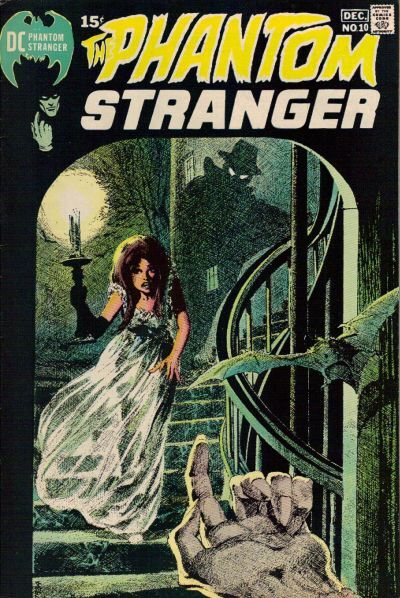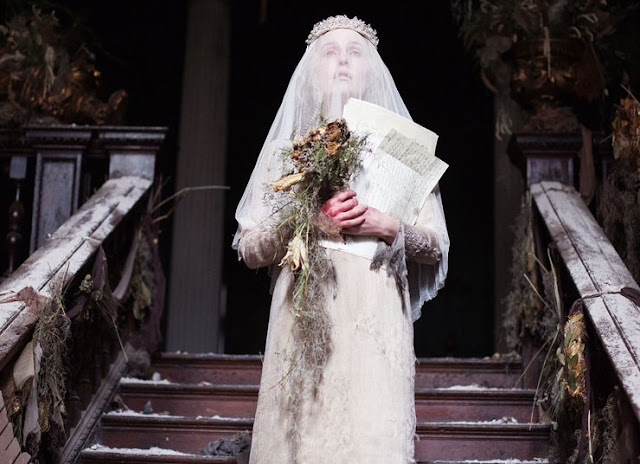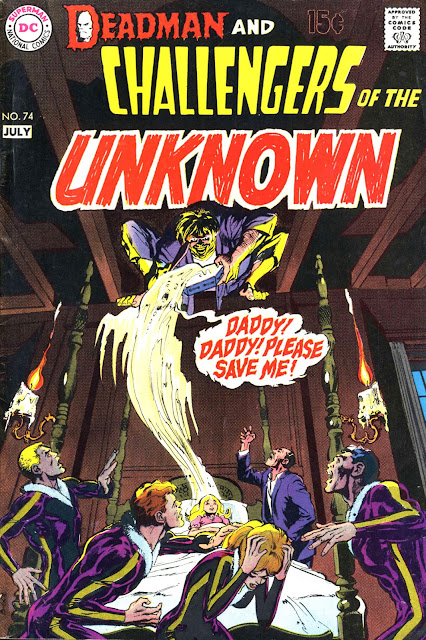25th December 2020 Advent Calendar
A beautiful woman clutching a candle descends the staircase to the basement of a sinister house--
Ahead of her a bony hand beckons-- she cannot resist-- she must keep going downwards to her inevitable doom--
And on the wall behind her lurks the shadow of some strange phantom, its eyes mysteriously aglow--
Neal Adams' cover for THE PHANTOM STRANGER #10 is pretty much textbook Horror imagery--Throw in the obligatory bat and the image is complete. Well, almost-- Adams employs one more technique commonly used by creators of Horror imagery in the late 60s/early 70s-- and it's a somewhat subversive one for a comic with the seal of the Comics Code Authority proudly displayed on its cover. But we'll get to that later.
First, let's get an overview of some of the other DC anthology covers from around this time using a similar central subject-- In 1968 DC's Horror Anthology HOUSE OF MYSTERY underwent a makeover, artists Joe Orlando and George Roussos introducing a darker, more sinister tone for the cover of #174 in contrast to the brighter colours and pulp sci-fi trappings of previous issues. The sinister illustration features an unseen figure with glowing slitted eyes, its bony hand beckoning a group of young children through the heavy wooden doors towards the darkness within. With this cover the template was set for the next few years, as covers for this title and DC's other anthologies, including PHANTOM STRANGER featured variations on the adult concept of innocents -sometimes children, sometimes young women - being lured to unspeakable horrors or witnessing sickening, inhuman deeds.
The following issue of HOM Neal Adams took over cover-art duties, quickly establishing himself as the go-to artist for DC's Horror anthologies for the next three years or so, as well as being hotly in demand for their Superhero titles. Adams and other cover artists such as Nick Cardy were clearly being influenced in their imagery by Horror movies, most particularly I would assume the Universal movies of the 30s and 40s and the Hammer films of the 60s.
As well as depicting monstrous male characters, Horror posters of this period frequently portrayed women as their inevitable victims-- always beautiful and often dressed in a very specific way. Here Mike Kaluta employs the services of a blonde-haired beauty in a white gown to adorn his cover for HOUSE OF MYSTERY 210--
A similar lady is seen hurrying down the staircase on the cover of HOUSE OF SECRETS #88, another Neal Adams painting-- Perhaps it's the same girl?
And the blonde lovely can be sighted again, it seems, this time courtesy of Nick Cardy on the cover of HOUSE OF SECRETS #95. Here she's being dragged up the stairs by an array of unsavoury looking fellows--
Returning to Adams' cover for THE PHANTOM STRANGER, let's look at some of the most obvious influences on its construction. The image depicts a woman in a white nightdress walking down a winding staircase towards a beckoning hand with a look of terror on her face. But she's still descending towards it, seemingly unable to resist--
Indeed there is no shortage of beautiful women wearing long white dresses in spooky locations in the Horror universe, here's a typical example-- Barbara Steele in THE LONG HAIR OF DEATH-- released in 1964, a handful of years before the comics covers above, and very much the sort of film that would appeal to readers of Horror comics at that time--
Three decades earlier the 1932 movie WHITE ZOMBIE featured Madge Bellamy's character transformed into a mindless slave by Bela Lugosi's character, or as the film poster's tagline described it-- 'He rendered her powerless ... He made her perform his every desire'. Movies like this popularised the narrative device of a woman being drawn to evil, sometimes willingly sometimes not, and the outfit of choice for such a scenario was -yes, you've guessed it- the long white dress--
But Adams' PHANTOM STRANGER cover includes two specific additional elements that were also well-established within the Horror genre-- the candle as the sole source of light and the staircase leading to darkness and the unknown-- death or subservience or sexual awakening or insanity or maybe all of them or maybe something else altogether. One of the best examples is 1945's THE SPIRAL STAIRCASE, actress Dorothy McGuire here seen descending the curving stairs to the darkened basement, a glowing candle held before her--
Then in 1957's CURSE OF FRANKENSTEIN Hazel Court donned her virginal white dress to go exploring the secret depths of her fiancé's castle by candlelight--
Or perhaps Adams was channelling 1961's THE INNOCENTS, this time featuring Deborah Kerr with the long dress and candles on another spooky staircase in a particularly spooky house--
Or maybe this was the inspiration, cult French erotic horror maestro Jean Rollin's LE VIOL DU VAMPIRE made in 1968-- surprise, surprise all the elements are once again in place--
So yes, it's a familiar trope, and there are lots and lots of examples and variations to enjoy in comics too. This cover from CREEPY #39 employs the woman in the white dress, the staircase to the cellar and the upraised candles, but dispenses with the look of trepidation on the lady's face. Clearly this well-coiffured dolly is in league with the green-pallored ghoul and his other-worldly pets. In this image she's not so much the victim, as the perpetrator of some as-yet undisclosed unspeakable act--
Or there's this air-brushed eighties hottie from the cover of Eerie #138-- the candle's been replaced with some kind of glowing wand and she appears to be striding through a modern city, but the overall effect is very familiar--
Of course, neither Adams nor the creators of the Warren covers above may have actually seen either of the above-mentioned films, but stills from Horror movies would have been commonplace in books and magazines when they were sketching them out, a well-known source of inspiration for artists in the pre-digital age. And the Horror comic book covers of the late 60s and early 70s would have been consciously emulating movie posters of the time and their depictions of sinister males threatening unspeakable things to white-clad damsels--
The poster for THE BRIDES OF DRACULA even featured five such ladies, because let's face it-- that Dracula certainly puts it about--
And often these posters were charged with a dangerous eroticism, an element which some of the DC Horror anthologies hinted at, though less overtly than the lurid movie promotional images (more of which later)--
So what exactly is this obsession film-makers and comic artists seem to have with women dressed this way, and placing them in unspeakably vile situations? The visual idea of a woman in a white dress being victim to a sinister or supernatural wrong-doer actually predates even the earliest Horror movies. 19th Century penny-dreadful artists understood that centuries of painters had established white clothing as symbolising untarnished innocence, purity and virginity, and were quick to capitalise on the way it could be contrasted with the darker shades in which they depicted their villains. Here is a typical example from VARNEY THE VAMPYRE published in the 1840s.
In 1931 Universal Studios' DRACULA presented Bela Lugosi's black-clad Dracula preying on this white-robed lady--
The film also introduces us to Dracula's harem of undead brides-- other women who have similarly been lured to their doom by the vampiric count--
The intended suggestion is that this form of dress, whether it is a nightdress or some other gown, is like a wedding dress, that the woman in question is being offered up to the male vampire as if in marriage - or sacrifice. This idea is even reinforced with the visual prompt that Dracula is carrying his latest 'bride' over the threshold of his coffin-filled cellar--
Similarly in 1935 Universal's BRIDE OF FRANKENSTEIN famously featured Elsa Lanchester draped in a long-white 'bridal' garment, having been reanimated by the deranged scientist as a mate for his frustrated creation (spoiler warning-- it doesn't end in marital bliss)--
In MGM's MAD LOVE/THE HANDS OF ORLAC also made in 1935, actress Frances Drake played the crazed Peter Lorre's girlfriend. This image, a publicity shot for the film, presents her like a sacrificial virgin in her flowing white gown.
So the connections between brides in their white dresses and sacrifice and falling victim to a devious male beast's clutches are all well-established in movie imagery as much as comics. Here's a Berni Wrightson cover for HOUSE OF SECRETS #94, in which the woman is depicted being carried like a bride over the threshold--
The idea was certainly a popular one, having also featured on the posters for Hammer's 1968 film THE DEVIL'S BRIDE/THE DEVIL RIDES OUT--
Neal Adams plays with the idea again here on the cover of THE PHANTOM STRANGER #12, though this pallid-toned 'bride' is clearly already dead--
So is the bride in this image-- a transparent, ghostly figure descending the staircase on the front cover of THE WITCHING HOUR, another Nick Cardy creation--
Interestingly this Horror trope was also recreated in Sarah Phelps' re-telling of Charles Dickens' GREAT EXPECTATIONS, a BBC adaptation made in 2011 starring Gillian Anderson in the role of the spectral jilted-bride, Miss Havisham, the jilted bride who has spent her entire life like a ghost shut up in her mansion still wearing her wedding clothes. And here she is descending a spooky staircase in time-honoured fashion.
But there's one other element to Neal Adams PHANTOM STRANGER cover which also became something of a Horror tradition, especially those produced by Hammer, in the 60s and 70s. If we take one more look at his image we notice that the girl's dress is being rendered slightly transparent as if by some additional unseen light-source behind her--
This publicity still of Carol Borland from 1935's MARK OF THE VAMPIRE is one of the first examples of this particular effect being used in the promotion of Horror movies-- As well as lighting the subject from the front, the photographer has placed an additional light behind her, so that as she stretches out her arms the white robes become see-through so that we can make out the vague outline of her body--
For Day 22 please click here--
For Day 21 please click here--
For Day 20 please click here--
For day 19 please click here--
Tweets by top_notch_tosh











































Comments
Post a Comment